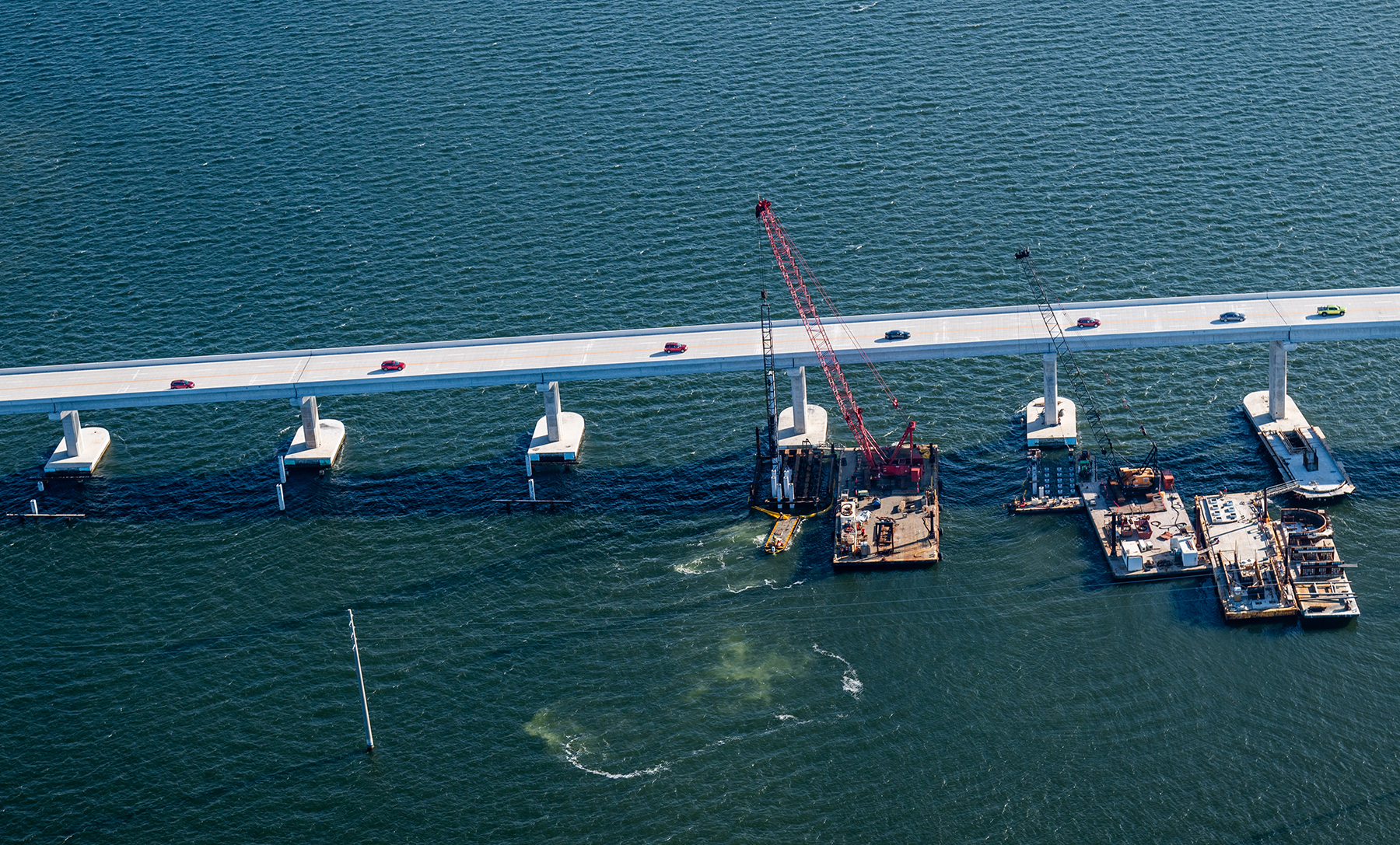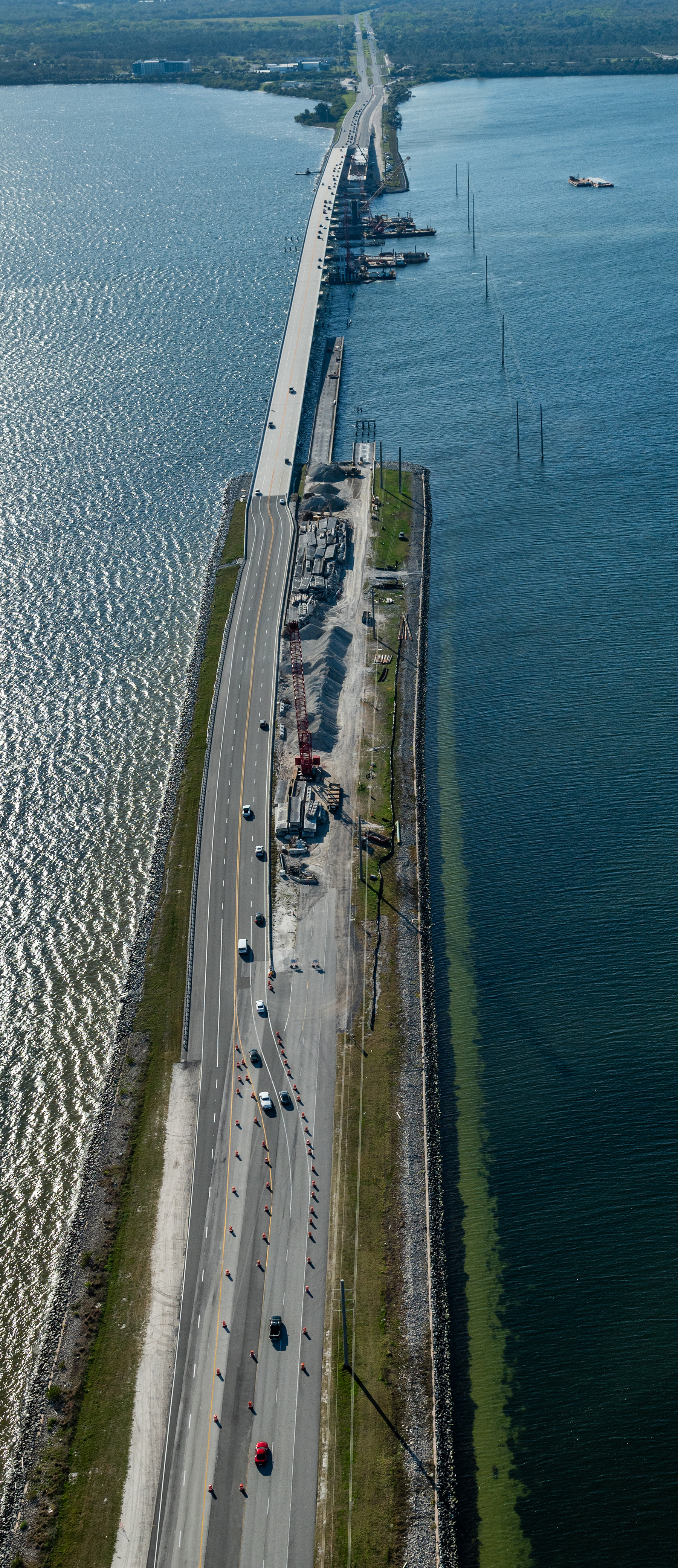By Robert L. Reid
NASA is replacing two bascule bridges that cross the Indian River Lagoon between Titusville, Florida, and the nearby Kennedy Space Center. Known as the NASA Causeway bridges, the original concrete structures date to 1964 and are being replaced by two high-level, fixed-span concrete crossings that will provide more than 65 feet of vertical clearance above the Indian River Lagoon, obviating the need for movable structures. The $126 million project is led by a partnership between NASA, the Florida Department of Transportation, and Space Florida, a state government entity that promotes aerospace activity in the region.
Further reading:
- NASA beach project requires the right stuff — even for Florida sand
- How to roll your way to the moon and Mars
- Can fewer studs of a larger diameter work for composite steel bridges?
Due to the age and bascule design of the original bridges, they were eligible for listing on the National Register of Historic Places. Because of this, the project went through an extensive Project Development and Environment study to look at alternatives to improve transportation and support the structural needs of space freight activities.

Volkert Inc., headquartered in Mobile, Alabama, was hired to lead the PD&E study and serve as the engineer of record for the 4,025-foot-long bridges. “The NASA Causeway bridges play a vital role in the economic development and growth of the Space Coast region of Florida,” says Ralph Bove, who served as the project manager for the PD&E study and is Volkert’s contract manager for the project.
Due to their age and condition, the original bridges were restricted in July 2019 for load and speed. The bridges did not have sufficient structural capacity to support some of the new heavy flight hardware that could be transported over the bridge.
Eastbound, westbound work
The eastbound bridge was completed in June 2023 – 125 days ahead of schedule. Work on the westbound crossing is underway and expected to be completed early in 2026, according to FDOT. The bridges are being constructed by Houston-based Orion Group Holdings Inc.
“The eastbound bridge was designed and constructed wider than the westbound structure – 53.67 feet versus 42.67 feet – because it is carrying traffic in both directions while the westbound bridge is under construction,” says Jim Lynch, P.E., a senior project engineer for WSP, which is providing construction engineering and inspection services. When the project is completed, each bridge will feature two lanes of traffic and a 3% incline, rather than the 5% incline of traditional fixed crossings, to accommodate the requirements of the spaceflight components being conveyed across the bridges.
“The NASA bridge project presented us with unique design challenges due to the need to accommodate space freight transport vehicles and satisfy vessel impact requirements,” says Alexander Caso, P.E., Volkert’s structures engineer of record for the bridges. The new crossings are designed to support the transportation needs of the space industry at KSC for the next 75 years, Caso adds.

Much of the construction work was conducted from barges, but the original bascule bridges were also used temporarily to maintain traffic flow and stage construction equipment and material. The original spans are being demolished.
Each new bridge will consist of 26 spans supported on hammerhead piers atop prestressed, hollow 30-inch-square concrete piles that extend to depths of about 95 feet beneath the riverbed. As the piles were being constructed, floating turbidity barriers were used to prevent sediment or debris from polluting the waterway. Because the project is within the 140,000-acre Merritt Island National Wildlife Refuge, there were “a lot of eyes on the construction,” including state and federal environmental agencies and other stakeholders, Lynch says.
Scheduling challenges
The project schedule was perhaps the most challenging aspect of the work, Lynch notes. “Everybody involved really had to look ahead at the work upcoming to clear any kind of administrative hurdles that might slow the project down or prevent us from doing a particular activity,” he says.
Orion, for example, sequenced the construction phase so its crews could work on columns, pile caps, beams, and the bridge deck simultaneously. And because concrete could not be poured without shutting down traffic lanes, which affected the space center and the public, a lot of the work had to be done at night and on weekends, Lynch says.
Because the work was being done along the Florida coast, the project had to have a hurricane plan in place along with the more traditional safety and quality plans. This proved prescient, as two large storms – hurricanes Ian and Nicole, both in 2022 – struck the region during the construction of the new eastbound span. Fortunately, the new bridge was not damaged, and the hurricane plan enabled work to continue on schedule.
To ensure that the existing bascule bridges could still open and close during the early phase of construction, a generator and submarine electrical conduit were relocated to maintain a backup power source – work that took three weeks to complete and had to be scheduled around the weather.
Although weather can be a factor at any construction site, work on the new bridges must contend with one out-of-the-ordinary-type of interruption: rocket launches. Such launches from the space center are increasing, Lynch notes, and “generate a lot of interest from the public.” This is especially the case when crewed launches are scheduled, and large crowds show up to watch. In response, NASA sets up a security perimeter on the west side of the bridges next to the project access point.
This article is published by Civil Engineering Online.



